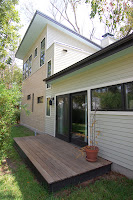In the late 18th- and early 19th-centuries, green building was taken for granted... only back then, it was just called "building." Conservation of resources, use of indigenous building materials, and siting a building for prevailing winds and passive solar gain were considered not only good sense, but vital to the structural integrity of the building and the survival of its inhabitants.
The"dog trot" house, a dwelling type commonly built in the southeast before air conditioning became ubiquitous, is a good example. The classic dog trot was raised off of the ground to allow air to circulate under the house. It typically was comprised of two rooms-- a cooking/eating area at one end, and a sleeping area at the other-- separated by an open breezeway. The breezeway offered a cooler, covered area for sitting, and acted as a "central air conditioner" when windows were opened in the two adjacent rooms. The photo at left is of a modern interpretation by architect Stephen Atkinson (photo by Timothy Hurley).
Today most people aren't willing to forgo air conditioning, but it still makes good sense to site a house for prevailing breezes and optimal daylighting. In Texas, north-facing windows are desirable because they allow for a diffused natural light without heat gain, since the sun is always to the south at our geographic latitude. Roof overhangs on the south facade of a building will help to block heat gain during the summer, when the sun is higher overhead, but will still allow some heat gain in the winter, when the sun is lower in the sky. The Caswell Residence, at right, has a roof that vaults to the north and large, north-facing windows to provide the upstairs study with diffuse daylight.
Green design's emphasis on sustainability encourages the careful selection of building materials as well. My friends Jill and Kenan, owners of the Yaspar Residence, asked that we design their addition with the tenets of bioregionalism in mind. Consequently we tried to use as many locally harvested and sourced materials as possible, including long-leaf pine flooring reclaimed from old barns in the area. We also used hardiplank siding, which is composed of a cellulose fiber and cement mixture. While not a locally harvested material, it's considered "green" in the sense that it requires very little maintenance and has a long lifespan relative to many other building materials.
Metal roofing is considered a green alternative to composite shingles, due to its lifespan and the fact that it keeps a building cooler. It can be made even greener by installing it on 3/4" furring strips and combining a ridge vent with a perforated roof drip edge-- this allows air to move in between the metal and the wood roof decking, which helps to cool the roof without introducing any outside air into the building itself. Foam insulation is another product that works toward greater energy efficiency. While polyurethane foam is a great acoustic and thermal insulator, there is a soy-based version that reduces the percentage of petroleum in the composition of the foam.
Green design should always fit the building to the site, which means retaining as many of the desired trees and as much native vegetation as possible. Dead trees can be harvested and locally milled for incorporation into the design, such as the walnut bar counter and trim at the Yaspar Residence (above), and the pecan bar counter and trim at the Courtyard Residence (at left).
There are a number of programs at the national and local level that encourage green building and provide more information on sustainable design. The City of Austin's Green Building Program was one of the first programs in the country to encourage green building. The U.S. Green Building Council's LEED program (Leadership in Energy and Environmental Design) accredits professionals in sustainable design and provides a rating system for green building design and construction. For more information on green building materials, products and techniques, check out websites like Jetson Green or Green Building Advisor. Or just give us a call!





